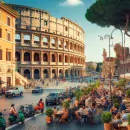
Italy, the birthplace of the Roman Empire, is home to one of the world's most beautiful languages - Italian. With over 85 million speakers worldwide, Italian is one of the most widely spoken languages in Europe and the world. In this blog post, we'll explore the history, characteristics, and significance of the Italian language.
History of Italian Language:
Italian evolved from the spoken Latin language of the Roman Empire, which was the language of government and education during the Roman Republic and Empire. The first written records of the Italian language date back to the 10th century, and it was initially used as a literary language in poetry and song. However, it wasn't until the 14th century that Italian became the official language of Italy.
During the Renaissance, Italian language and culture experienced a significant revival, with scholars and artists from all over Europe flocking to Italy to study Italian literature and language. As a result, Italian became the lingua franca of the educated elite, with many famous writers, such as Dante Alighieri, Petrarch, and Boccaccio, contributing to the development of the Italian language.
The history of the Italian language can be traced back to the 1st millennium BC, when a group of Italic tribes migrated from the eastern coast of the Adriatic Sea to the Italian Peninsula. These tribes spoke various dialects of a common language that would eventually evolve into Latin.
During the Roman Republic and Empire (753 BC - 476 AD), Latin became the language of government and education, and it spread throughout the Mediterranean world. After the fall of the Roman Empire, Latin evolved into various Romance languages, including Italian.
The first written records of the Italian language date back to the 10th century, in the form of documents written in the Southern Italian dialects of Sicilian and Tuscan. The Tuscan dialect would eventually become the basis of standard Italian.
During the Middle Ages, Italy was a collection of city-states and independent regions, each with its own dialect. The literary language of the time was a hybrid of the various dialects, known as "volgare illustre" (illustrious vernacular). This literary language was used by writers such as Dante Alighieri, Petrarch, and Boccaccio.
In the 16th century, the Tuscan dialect became the official language of Italy. The first grammar of the Italian language was published in 1582 by Giovanni Francesco Fortunio. The Accademia della Crusca, founded in Florence in 1583, became the guardian of the Italian language, establishing rules and norms for the language.
In the 19th century, Italy was unified as a nation-state, and standard Italian became the official language of the country. During this time, efforts were made to promote the use of standard Italian and to eradicate regional dialects.
Today, Italian is spoken by over 85 million people worldwide and is one of the official languages of the European Union. It has a rich cultural heritage, with some of the most significant works of art, literature, and music in the world coming from Italian artists, writers, and musicians.
Characteristics of Italian Language:
Italian is a Romance language, which means it has its roots in Latin and shares many similarities with other Romance languages such as Spanish, Portuguese, and French. Italian is known for its musicality, with its rhythmic cadence and emphasis on vowels making it a beautiful language to listen to.
Italian grammar is relatively straightforward, with clear and consistent rules for verb conjugation and noun declension. Like all Romance languages, Italian makes use of gendered nouns and adjectives, with masculine and feminine forms for most words.
Italian is a Romance language and is known for its melodious sound and rhythm. Here are some of the key characteristics of the Italian language:
-
Vowels: Italian is a language that places a strong emphasis on vowels, which are pronounced clearly and distinctly. Vowels are often elongated, giving the language a musical quality.
-
Grammar: Italian grammar is relatively simple, with clear and consistent rules for verb conjugation and noun declension. Like all Romance languages, Italian makes use of gendered nouns and adjectives, with masculine and feminine forms for most words.
-
Pronunciation: Italian pronunciation is generally straightforward, with each letter having a clear sound. The language also makes use of double consonants, which are pronounced with a slight pause between the two sounds.
-
Word order: Italian sentence structure is typically subject-verb-object, but it is flexible, and different word orders can be used for emphasis or to create different meanings.
-
Regional dialects: Italy is a country with a rich linguistic heritage, and there are many regional dialects spoken throughout the country. Some of these dialects are so distinct that they are almost separate languages.
Overall, Italian is a beautiful and expressive language with a rich cultural history. Its musicality and clarity make it an enjoyable language to learn and speak.
Significance of Italian Language:
Italian is not just the language of Italy; it is also the official language of Switzerland, San Marino, and Vatican City. It is also widely spoken in Croatia, Slovenia, and parts of France, Monaco, and Greece.
Italian has a rich cultural heritage, with some of the most significant works of art, literature, and music in the world coming from Italian artists, writers, and musicians. From Michelangelo's sculptures to Verdi's operas, Italian culture has made a significant contribution to the world's artistic legacy.
In conclusion, Italian is a beautiful and important language with a rich cultural history. Whether you're interested in studying the Italian language for travel, business, or personal enrichment, learning Italian can open up a world of opportunities and deepen your appreciation for Italian culture.
Recent Posts

Understanding Translation Serv...

Agenzia di Traduzione a Roma: ...

Die Essentielle Rolle von Übe...

Die Essentielle Rolle von Übe...

Die Essentielle Rolle von Übe...

La Traduction Assermentée: Un...
Share it.
© Copyright 2022 LLC


